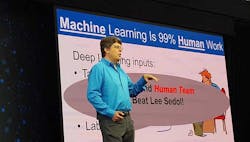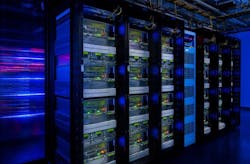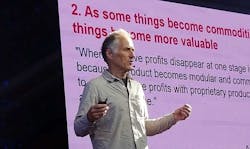Beyond SkyNet: Reframing AI as a Force for Good
Today we begin a series of stories on artificial intelligence and its potential impact on the technology sector and Internet infrastructure.
NEW YORK – Call it the SkyNet Problem. News stories about artificial intelligence or robotics often include a joking reference to the technology becoming self-aware, or ushering in our New Robotic Overlords.
It’s not an accident that Americans wonder if artificial intelligence (AI) will turn the tables on its creators and subjugate humanity. It’s a reflex drilled home by decades of blockbuster Hollywood movies like the “Terminator” series or “The Matrix” series or “Alien” or “Westworld” or “Avengers: Age of Ultron” or “Tron” or “Blade Runner” or “War Games” or “I Robot” (Will Smith version) or … well, you get the picture.
This anxiety presents a challenge for companies building the new generation of AI technologies, as well as the data centers that will power them. Public resistance to AI could serve as a drag on the adoption of new tools, devices, and services, which is poised to accelerate over the next several years.
The technology community is stepping up its efforts to reassure the public about AI’s potential to be a force for good. Last week Google, Facebook, Microsoft, IBM and Amazon teamed to launch the Partnership on Artificial Intelligence to Benefit People and Society, an initiative to “advance public understanding” of artificial intelligence and address ethical problems that arise from it.
It’s an acknowledgement that artificial intelligence is entering uncharted territory, as a huge investment in R&D spurs rapid improvements in AI. As tech titans forge ahead, there’s growing awareness of a gap between Silicon Valley’s comfort level with AI, and the way consumers perceive the technology.
Massive Investment Ahead
The partnership was unveiled as the leading researchers in AI gathered in New York for a conference organized by Tim O’Reilly, the tech visionary who helped popularize the open source movement and “Web 2.0.” O’Reilly says the current pace of innovation in AI requires a broader conversation about its benefits and risks.
“I think we’re going to have a series of massive investments that will bring the AI era into the everyday world,” said O’Reilly, who keynoted the event at the Javits Center. “We have to do it better. People get scared. They start to see technology as an enemy. There’s a massive responsibility, as we build AI systems, to examine the consequences of our decisions.”
Those tensions are reflected in the work of Genevieve Bell, who directs Corporate Sensing and Insights for Intel, the world’s largest chipmaker. Bell is an anthropologist who studies how humans interact with technology, and says AI is a cultural phenomenon unto itself.
“Hollywood tells us AI is going to kill us in a robot apocalypse,” said Bell. “If we listen to the news, it’s going to replace us and take our jobs. The reality is infinitely more complicated. We already live in a world riven through with algorithms.”
“AI is not going to exterminate us, it’s going to empower us,” said Oren Etzioni, CEO of the Allen Institute on AI, a think tank backed by Microsoft co-founder Paul Allen. “AI has a huge potential benefit for humanity. I think this mission of AI for the public good is resonating more and more.”
AI in the Everyday World
Most Internet users aren’t aware of the ways they interact with artificial intelligence, which is embedded in many everyday tasks. For example, every time you upload a picture, Facebook uses AI to identify your friends in the photo and suggest that you tag them.
Facebook’s computers can recognize faces in images within two seconds, according to Yann LeCun, the Director of AI Research at Facebook, who said users upload between 1 billion and 1.5 billion photos each day.
That requires a lot of computing horsepower. Facebook uses custom servers packed with high-end graphics processing units (GPUs) to train its facial recognition system. There are thousands of these servers in the company’s data centers in Oregon and North Carolina, bringing 40 petaflops of power to bear on the task.
Racks packed with Big Sur servers inside the Facebook data center in Prineville, Ore. Each rack holds four of the GPU-accelerated chassis, which crunch data for artificial intelligence applications. (Photo: Facebook)
Facebook isn’t alone. There are similar deployments of custom hardware powering AI in data centers operated by Google, Microsoft, Amazon and IBM, along with a slew of startups. These investments in AI are transforming these companies’ data centers and their capabilities.
“We’re entering a new generation of compute and a new generation of AI,” said Jim McHugh, VP and General Manager at NVIDIA, whose GPUs are deployed in many AI labs. “We’re hitting a point where AI is changing things in many industries.”
‘Golden Age of Machine Learning’
“We’re in a golden age of Machine Learning and AI,” said Ralf Herbrich, Director of Machine Learning Science and Core Machine Learning at Amazon, which leases GPU-powered servers for AI data crunching through its AWS cloud service. “We are still a long way from being able to do things the way humans do things, but we’re solving unbelievably complex problems every day and making incredibly rapid progress.”
“Over the past five years, we’ve seen tremendous advances in the deployment of AI and cognitive computing technologies,” said Francesca Rossi, an AI Ethics Researcher at IBM Research, adding that AI’s impact ranges from “useful consumer apps to transforming some of the world’s most complex industries, including healthcare, financial services, commerce, and the Internet of Things.”
The O’Reilly conference showcased a number of promising new applications of artificial intelligence. Some examples:
- Lumiata analyzes patient records against a “medical graph” of research and clinical data to identify potential health risks and recommend medical interventions.
- Insilico Medicine uses artificial intelligence for predictive medicine, identifying “biomarkers” for diseases and recommending new drugs to treat them.
- Zebra Medical Vision trains computers to read medical images for X-rays, improving early detection of osteoporosis.
- Enlitic applies machine learning to radiology, providing deep analysis of scans to detect tissue abnormalities that might go unnoticed, potentially providing early detection of cancers.
- Brain Power uses AI and facial recognition to develop immersive games for youth on the autism spectrum. The games, experienced through Google Glass, help users read emotions through facial cues, a common challenge for these children.
The sexiest AI project is the technology industry’s effort to perfect self-driving cars. Google, Tesla, Uber, GM, Apple, NVIDIA and Mercedes are among the companies developing autonomous vehicles, which could create radical change in American transportation and urban life. There are huge challenges and resistance points, but technologists say autonomous cars offer an enormous societal benefit.
“About 30,000 people are killed in cars every year,” said Shahin Farshchi, a partner at Lux Capital, which invests in cutting-edge tech companies. “By being marginally better than people, (self-driving cars) will save many, many lives. Human drivers are actually pretty bad. It’s not a high bar for AI to pass.”
Shahin Farshchi, a partner at Lux Capital, says autonomous cars could save thousands of lives. (Photo: Rich Miller)
That’s why Farshchi sees autonomous cars as an example of AI technology that should be fast-tracked, rather than implemented at a deliberate pace. “This technology exists, the sensors exist and everything is coming down in cost,” he said. “By postponing the release of autonomous cars, we are losing many lives.”
The gatekeeper on this, Farshchi said, will be the U.S. government. President Barack Obama is well versed in the issues around AI, and differentiates between “general intelligence” that equips machines to think independently – which AI researchers acknowledge is years or perhaps decades in the future – and the specialized AI algorithms that are being rapidly integrated into existing apps and technology.
“We’ve been seeing specialized AI in every aspect of our lives, from medicine and transportation to how electricity is distributed, and it promises to create a vastly more productive and efficient economy,” Obama said in an interview with WIRED. “If properly harnessed, it can generate enormous prosperity and opportunity. But it also has some downsides that we’re gonna have to figure out in terms of not eliminating jobs. It could increase inequality. It could suppress wages.”
What Will AI Mean for the Workplace?
The most likely battles on the horizon may be turf wars over artificial intelligence’s role in the workplace. “AI’s impact on jobs is a very real concern,” said Etzioni of the Allen Institute. “That’s what we ought to be discussing, not existential risks and the Terminator scenarios.”
Robotics and technology-driven automation have had been forces for disruption for decades, especially in factory environments. Artificial intelligence has the potential to amplify that trend.
In a 2013 study, Oxford University researchers Carl Frey and Michael Osborne studied more than 700 occupations, and found that 47 percent of American workers had jobs at high risk of potential automation.
Tim O’Reilly chose to address this concern in his conference keynote.
“Increasing machine productivity will not destroy our economy,” he predicted. “We have this assumption about the economy that it’s this game in which it’s all about removing humans as a cost so we can increase the profits. But in fact a great economy comes from investing in people. Is there plenty of work to go around? Absolutely. Could we use machines to help us do it? Absolutely.”
Tim O’Reilly discusses AI’s impact on the workplace in his keynote at the O’Reilly Artifical Intelligence Conference in New York. (Photo; Rich Miller)
O’Reilly articulated the optimistic view of artificial intelligence that animates technologists and investors in Silicon Valley.
“Technology is the solution to human problems,” he said, noting the statement by venture capitalist Nick Hanauer that “we won’t stop needing technology until we run out of problems. ”
“The fundamental problem of our time is not technology taking away jobs, it’s the choices we make,” said O’Reilly. “As AI turns more of what we do today into a commodity, new things will become valuable.”
More specifically, new skills will become valuable. Retraining of displaced workers can be difficult, especially for older employees. That’s a factor in America’s current economic anxieties, particularly when factory jobs depart and workers struggle to find work that pays the same wages. It’s a tension that’s clearly visible in the 2016 election, and the discussion will persist as “software eats the world,” disrupting more industries and making tech skills central to a growing number of jobs.
Etzioni said the key job skill going forward will be coding. “In the future there may be two kinds of people – those that tell computers what to do, and those that computers tell what to do,” he said.
NEXT: Some of the challenges in building accountability and trust around artificial intelligence that the technology sector must address, and strategies for the road ahead.
About the Author





